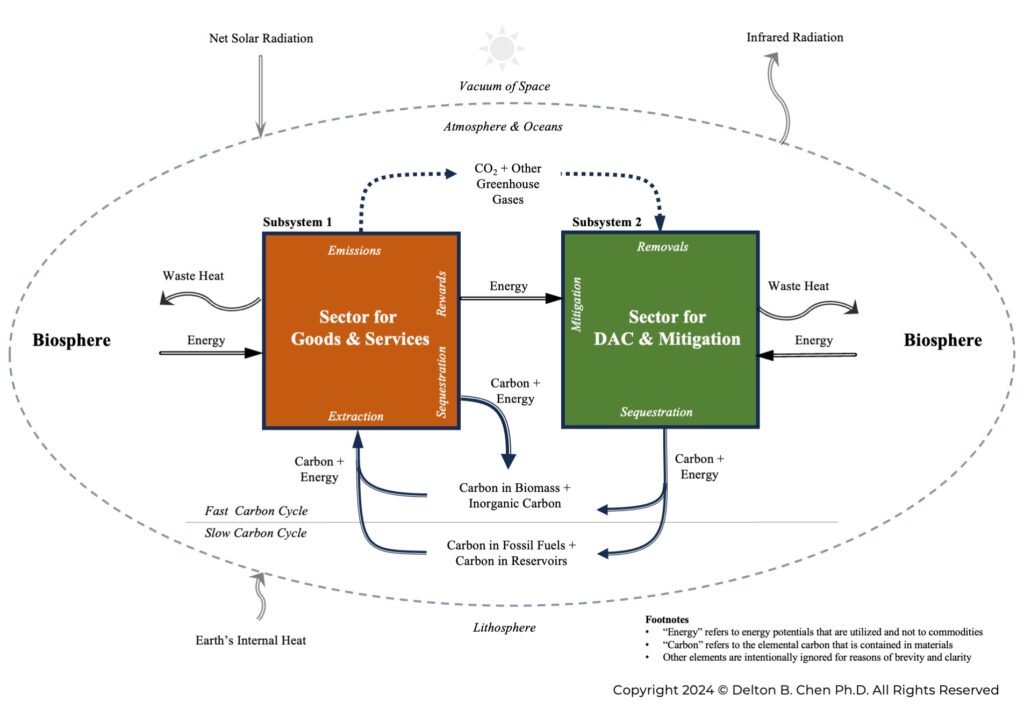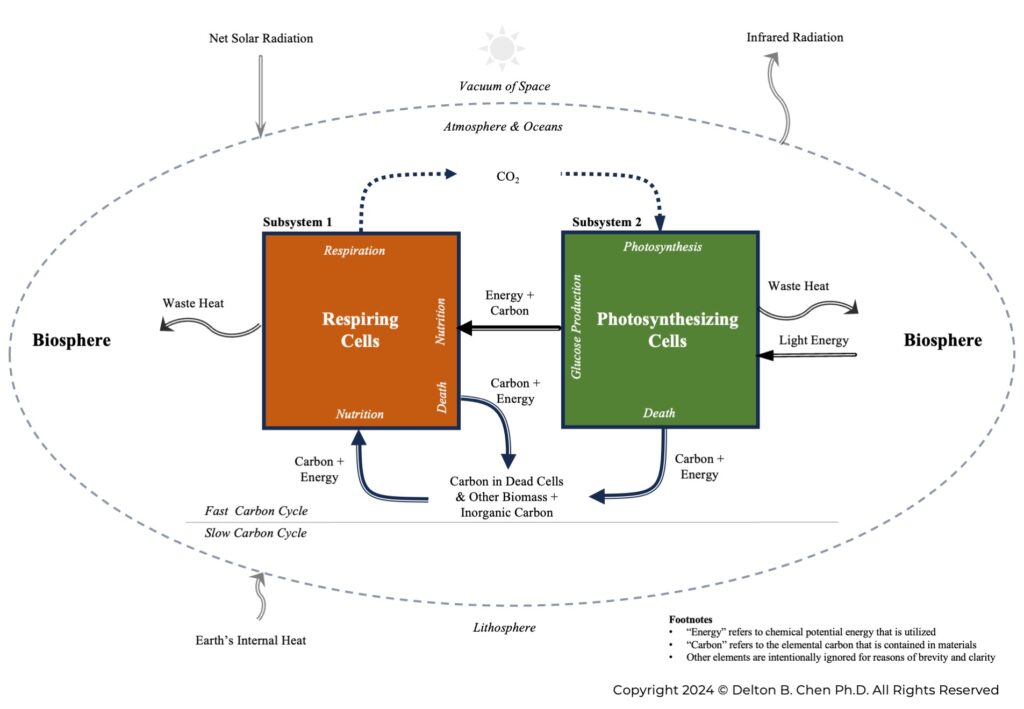Biophysical Analysis
My biophysical analysis suggests that a globally applied carbon reward can be used to actively manage the carbon cycle to achieve net-zero emissions while protecting ecosystems and human wellbeing.
— Delton Chen
Updated 21 November 2024
Introduction
The first two models of the world economy are the (1) steady state economy, and the (2) heat engine economy. These models are discussed in relation to a controversial idea in economics, called ‘degrowth’. The third model, called the (3) living systems economy, is original to this project and it is introduced to explain how carbon and energy can be managed to resolve the climate crisis. Let’s begin by reviewing the first two models.
Steady State Economy
The steady state economy is associated with the school of ecological economics (see Figure 1). The steady state economy is similar to the circular economy framework because they both promote recycling. The steady state economy is associated with the idea that the economy may need to degrow (or spiral downwards) to eventually achieve a steady state condition that falls within the earth’s carrying capacity. This strategy appears reasonable at first glance given that global resource usage and waste generation are exceeding some planetary boundaries. Advocates of this kind of degrowth assume that a political movement should be established to change the direction of economic development. However, a precise and convincing policy toolkit for this kind of degrowth is currently lacking.
Although the steady state economy has some elements of a biophysical model, it also has a major shortcoming: it views stocks-and-flows from a socially-framed perspective by treating stocks-and-flows as commodities or ‘resources’. The alternative is to view stocks-and-flows as having a molecular structure with thermodynamic properties, and to evaluate the economy as a heat engine. The heat engine economy is focused instead on the dissipation of energy by molecules, chemical reactions, phase changes, and work done to produce goods and services and to extract ever more energy for civilization’s repair, function, and growth.
Heat Engine Economy
Tim Garrett (2009, 2014) examined the heat engine economy and proposed a new analytical model based on his review of key data, including global primary energy, GDP, and carbon emissions. Garrett’s heat engine economy differs significantly from the steady state economy because the heat engine economy includes a feedback-loop between accumulated wealth (defined by cumulative GDP) and primary energy demand. Some key interpretations of Garrett are:
- Each unit of economic production, measured in inflation-adjusted dollars, has a constant amount of primary energy consumption supporting it.
- Improving the energy-efficiency of civilisation allows it to grow faster and consume more energy, rather than reducing overall energy use (i.e. Jevons paradox).
- Stabilising carbon dioxide emissions at current rates would require new clean power added at the rate of about one large nuclear power plant (equivalent) per day.
According to Garrett, the heat engine economy will decay (i.e. degrow) if there is insufficient energy available for civilisation to repair/maintain itself and access new energy reserves. In other words, degrowth of the heat engine economy is envisioned to be a process of involuntary decay or collapse, and is not envisioned to be a political option. Garrett does not consider humanity as having the agency to change the relationship of primary energy demand to accumulated wealth. Thus, the heat engine economy tends to position the climate crisis as an intractable problem due to a systemic bias for economic growth and increasing energy demand.
At first glance, the heat engine economy delivers a pessimistic outlook for the future. But this is because the world economy is only functioning as a heat engine. Thermodynamics also allows for another kind of engine, called a ‘negative entropy engine’, or put more simply, a ‘negentropy engine’. Examples are refrigerators, desalination plants, and heat pumps used for cooling. These engines do not break the Second Law of thermodynamics because they only reduce the entropy of matter within a bounded system and not the entire universe. The term negentropy engine is used in the section below to denote a new global market for direct air capture (DAC) and conventional mitigation.
Living Systems Economy
Now, let’s consider the negentropy engine and its potential role in the third biophysical model of the economy, called the living systems economy (see Figure 2). The third model is unique because it is divided into two economic sectors (or sub-systems). The first sector is explicitly for producing goods and services, and implicitly for generating waste, including carbon emissions. The second sector is explicitly for neutralising the carbon emissions of the first sector using DAC (engineered, natural and hybrid methods) and conventional mitigation. It should be self-evident that the first sector is actually the heat engine that was originally described by Garrett (2009, 2014); and the second sector is actually a negentropy engine for neutralising carbon emissions.
The neutralisation of carbon emissions emanating from the first sector by the second sector will result in a new type of economic growth, called ‘balanced growth in carbon’. Balanced growth in carbon is different from degrowth because balanced growth is enabled by the sharing of resources between two sectors in order to achieve a specific carbon balance. The new sector for DAC and conventional mitigation will be managed as a global marketplace for carbon rewards (refer Figure 2).
When the economy experiences balanced growth, the mitigation by the second sector will crowd-out some production in the first sector because financial capital (and its embodied energy) will be reallocated to favour growth of the second sector at the expense of the first sector. Subsequently, the living systems economy will crowd-out consumption in relative terms or in absolute terms. If this crowding-out is absolute, then some degrowth in consumption will occur — but this does not necessarily mean that global GDP will reduce because mitigating activities supported by the second sector will contribute to GDP. In summary, global GDP in the living systems economy is treated as an independent variable.
As mentioned above, the two economic sectors in the living systems economy will work together in a mutual partnership. This partnership combines the heat engine (for producing goods and services) with the negentropy engine (for greenhouse mitigation). This approach is plausible, as shown in Figure 2, and it is analogous to symbiosis between respiring and photosynthesizing cells, as shown in Figure 3. Symbiotic relationships of this type are common, and are essential to plant biology and the survival of various species. Thus, the living systems economy is aptly named because it actually resembles the metabolic functioning of an ecosystem in an oxygenated environment.
A well-known paradox in global energy management is Jevons paradox. The paradox is that an increase in the energy-efficiency of production can result in an overall increase in energy usage (not a reduction) because improving productivity can stimulate more economic activity in total. Important, is that the living systems economy offers a solution to this paradox. The solution is to design the Global Carbon Reward marketplace to include a closed-loop controller based on information feedbacks and price feedbacks. In other words, the Global Carbon Reward policy includes a financial mechanism that can adaptively reallocate financial capital to achieve net-zero emissions at the global level. The resulting reallocation of financial capital will crowd-out some goods and services if this is necessary (refer above). This crowding-out will counteract any rebound in energy usage and carbon emissions that might otherwise occur through energy-efficiency gains.
Furthering this Analysis
Although the living systems economy defines an approach for overcoming the limitations of the steady state economy and the heat engine economy, the above discussion does not constitute a formal proof. Providing a formal proof for the living systems economy is a demanding theoretical task. Significant progress towards a formal proof has already been made however an acceptable proof will require a collaboration between scientists and physicists, and it will also require the support of a leading research institution. Institutional support is needed because the implications of the living systems economy are existential in nature, and could ultimately impact the policy discussions and negotiations under the UNFCCC.
If you would like to collaborate on this proof and related publications, please send your inquiry to the author, Dr. Delton Chen, via this website. Before contacting the GCR initiative about the new biophysical economic model, it is recommended that you first watch the video provided below which outlines the theory and philosophy of the approach.


